Michael Gallagher's Blog - Posts Tagged "crookes"
Why the Victorians saw ghosts: the full-body materializations of Florence Cook
 While I was researching my novel,
The Bridge of Dead Things
, I came to understand that the Victorian vogue for spiritualism did not happen in a vacuum. It grew out of a very specific culture, at a particular point in time, and it fulfilled a number of surprisingly different needs. This is the seventh in a series of posts that examines various influences on the development of spiritualism. **Please note that it is edited from articles that I have previously posted, but its inclusion here helps to make sense of the history.**
While I was researching my novel,
The Bridge of Dead Things
, I came to understand that the Victorian vogue for spiritualism did not happen in a vacuum. It grew out of a very specific culture, at a particular point in time, and it fulfilled a number of surprisingly different needs. This is the seventh in a series of posts that examines various influences on the development of spiritualism. **Please note that it is edited from articles that I have previously posted, but its inclusion here helps to make sense of the history.**Florence Eliza Cook was born on June 3rd 1856 in Cobham, Kent to parents Henry and Emma Cook, who moved to London when she was three and took up residence at 6 Bruce Villas, Eleanor Road, Dalston. She was the eldest of four children.
In 1870, at the age of fourteen, she began table-rapping experiments with her friends and family, surprising everyone when a violent burst of poltergeist activity ensued. A spirit responding to her questions through a system of yes-or-no raps informed her that she was indeed a medium and then directed her to the local Spiritualist Association. By the following year she'd started working for a pair of established mediums, Frank Herne and Charles Williams, and reports of her séances were beginning to crop up in the spiritualist press. Herne's spirit-guide was an entity named John King, who rather confusingly claimed to be the ghost of Sir Henry Morgan, the famous buccaneering pirate. Florence's guide was Katie King, John's daughter, who also claimed to be Annie Owens Morgan, the daughter of the pirate. At this point there was none of the bodily manifestations of Katie that came later; there were simply disembodied voices, messages written by unseen hands, and phenomena known as "apports"—objects that appeared to fall from the ceiling.
There is a truly fascinating story of one such occurrence: early in the June of 1871 Herne and Williams were conducting a séance together for eight sitters around a table at 69 Lamb's Conduit Street when the voices of Katie King and her father were heard in the darkness. Katie offered to produce a gift for the group and one of the sitters suggested—half jokingly—that she bring them Agnes Guppy, an extremely stout medium famed for her own apports who lived some miles away in Highbury. Katie laughed—everybody laughed—and though her father protested she agreed to go through with it. Suddenly there was a loud thump; somebody screamed. When one of the company had the presence of mind to light a lamp, there on the table in front of them, apparently in some kind of trance, was perched the stout Mrs Guppy in a state of semi-undress, account book and pen still in hand.

By the beginning of 1873 Florence was performing her own séances at the Cook family home in Dalston, but by now there were full materialisations. The audience, often comprised of highly respectable professional men and women, would sit in the dimly-lit parlour while Florence was bound by ropes before retiring to an adjoining room screened off from view by a thin damask curtain. Presently the spirit of Katie King would appear dressed in white, and walk about the room telling the story of her former life as Annie Morgan, the buccaneer's daughter. It was a charming tale. Annie had been twelve years old when Charles the First was beheaded; she'd married and had two little children; she'd committed more crimes than she cared to confess; she'd even murdered men with her own two hands; she'd died young. To questions concerning the reason of her reappearance back on earth, she claimed that it was part of the work she'd been entrusted with, to convince the world of the truth of Spiritualism.
In Spring of that year Florence Cook held a series of sittings designed to capture a photographic likeness of Katie. On the 7th of May, Mr W. H. Harrison, a reporter for the Daily Telegraph (who in later years went on to edit The Spiritualist, a London-based magazine dedicated to examining spiritualist phenomena from a scientific perspective), successfully managed to take the first four photographs of Katie. More sittings followed where the highly respected scientist William Crookes took a total of forty-four photos, all the while performing tests on Florence as part of his on-going investigation into spiritualist mediums. These sittings were held at Crookes's own house on Regent's Park, which was one of the conditions he imposed on all his test subjects.
Florence was fast becoming famous, but fame breeds jealousy. At a séance held on the 9th of December the lawyer William Volckmann seized Katie King by the waist and refused to let go. Some of those present claimed that the spirit "glided" out of Volckmann's grip; others suggest that she defended herself quite vigorously (Volckmann lost part of his beard). Edward Elgie Corner, a ship's captain from Dalston, who was a family friend of the Cooks as well as being their neighbour, together with another of her supporters rushed to Katie's aid. The gaslights were rapidly extinguished, there was a great deal of scuffling, and by the time peace was eventually restored and the room re-lit, Katie King had vanished and Florence was discovered still secured by her ropes. As Volckmann was most likely in league with Agnes Guppy (the formidable medium from Highbury who'd landed on the table in a state of semi-undress—whom he in fact married after her elderly husband passed away barely a year later), it would seem that Florence's relationship with her erstwhile colleague had soured considerably.
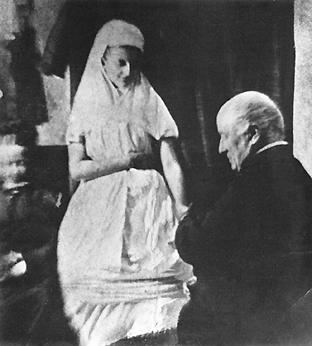
Volckmann's attack damaged her reputation. Unfortunately Crookes's report, Notes of an Enquiry into the Phenomena called Spiritual during the Years 1870-1873, published a month later in the Quarterly Journal of Science (January 1874) did little to restore it, despite his vehement assertion that Florence Cook, the American Kate Fox, and the Scotsman Daniel Dunglas Home, were all genuine mediums producing perfectly genuine results.
The séances continued. Florence teamed up with another girl, Mary Rosina Showers. The pair gave a séance at the Crookes home in March of 1874 which was attended by a number of witnesses, among them the barrister, Serjeant-at-law Edward William Cox. Cox took a deep—though not uncritical—interest in spiritualism; it was he who had first hosted and championed Daniel Dunglas Home on his return from America. He published his observations some weeks later in The Spiritualist, the leading newspaper in its field, which the reporter W. H. Harrison would go on to edit. Of the materialisations he wrote: "They were solid flesh and blood and bone. They breathed, and perspired, and ate…Not merely did they resemble their respective mediums, they were…alike in face, hair, complexion, teeth, eyes, hands, and movements of the body…"
As regards proof that they were not simply the two girls themselves, he wrote: "…no proof whatever was given or offered or permitted. The fact might have been established in a moment beyond all doubt by the simple process of opening the curtain and exhibiting the two ladies then and there upon the sofa, wearing their black gowns. But this only certain evidence was not proffered, nor, indeed, was it allowed us…"
On the 29th of April 1874 Florence Cook married Captain Edward Elgie Corner, the neighbour who had rushed to Katie's aid the previous December. Though their marriage was blessed with two daughters, Kate and Edith, it was not a happy one.
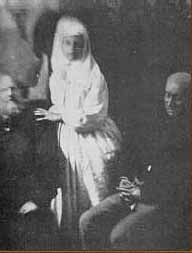
The final appearance of Katie King was a truly sad occasion. She had often stated that she could not appear on this earth beyond the month of May, 1874, and so, on the 21st, she assembled her friends together to bid them all goodbye. This eye-witness account was written by the stage actress and internationally successful author Florence Marryat:
"Katie had asked Miss Cook to provide her with a large basket of flowers and ribbons, and she sat on the floor and made up a bouquet for each of her friends to keep in remembrance of her. Mine, which consists of lilies of the valley and pink geranium, looks almost as fresh to-day, nearly seventeen years after, as it did when she gave it to me. It was accompanied by the following words, which Katie wrote on a sheet of paper in my presence: 'From Annie Owen de Morgan (alias "Katie") to her friend Florence Marryat Ross-Church. With love. Pensez à Moi. May 21st 1874.' The farewell scene was as pathetic as if we had been parting with a dear companion by death. Katie herself did not seem to know how to go. She returned again and again to have a last look, especially at Mr. Alfred [William] Crookes, who was as attached to her as she was to him."
Of that final parting, this is what William Crookes himself wrote: "Having concluded her directions, Katie invited me into the cabinet with her, and allowed me to remain there to the end. After closing the curtain she conversed with me for some time, and then walked across the room to where Miss Cook was lying senseless on the floor. Stooping over her, Katie touched her and said, 'Wake up, Florrie, wake up! I must leave you now.' Miss Cook then woke and tearfully entreated Katie to stay a little time longer. 'My dear, I can't; my work is done. God bless you!'…For several minutes the two were conversing with each other, till at last Miss Cook's tears prevented her speaking. Following Katie's instructions, I then came forward to support Miss Cook, who was falling on to the floor, sobbing hysterically. I looked around, but the white-robed Katie had gone…"
It would be impossible not to compare Cox's statement with that of Crookes's, or Florence's likeness with that of Katie's. But I will tell you this: I am absolutely convinced that William Crookes was not lying about what he saw.
Though Katie was never to appear again, Florence went on to host two further spirit-guides during her lifetime: firstly Leila in 1875 (the same year that Frank Herne, the medium who'd set Florence on her career-path was debunked as a fraud), and then later a French girl who called herself Marie, who was said to have "danced and sung in a truly professional style".
Five years on, Florence was ghost-grabbed for a second time, on this occasion by the young Sir George Sitwell, a 20-year-old Oxford University student, at a public séance being given at the rooms of the National British Association of Spiritualists in 1880. The débâcle ruined her, and she retired and moved to Wales. The incident brought Sir George some notoriety too and he soon left Oxford without taking a degree. He ended up fathering a daughter, the future Dame Edith Sitwell, truly England's most eccentric poet who became something of an entertainer herself. In 1923 she alienated her audience by standing out of sight behind a starkly-painted screen while shouting her poems at them through a megaphone, all in time to William Walton's carefully arranged score of Façade – An Entertainment.
In 1899 Florence tried to revive her career when she was invited to Berlin to undertake a series of séances under test conditions by the Sphinx Society. She died of pneumonia in relative poverty at 20 Battersea Rise, London, on the 22nd of April 1904 at the age of 48. Her husband outlived her by a quarter of a century and died in 1928.
William Crookes received his knighthood in 1897 and the Order of Merit in 1910. He died in 1919. Towards the end of his life he sought out mediums to help him communicate with his beloved wife, who had predeceased him by two years.
I'd like the last words to go to the fifteen-year-old Florence Cook herself. In a letter to Mr W. H. Harrison (the Telegraph reporter who would later take the first photographs of Katie), dated May, 1872, she writes: "From my childhood I could see spirits and hear voices, and was addicted to sitting by myself talking to what I declared to be living people. As no one else could see or hear anything, my parents tried to make me believe it was all imagination, but I would not alter my belief…"
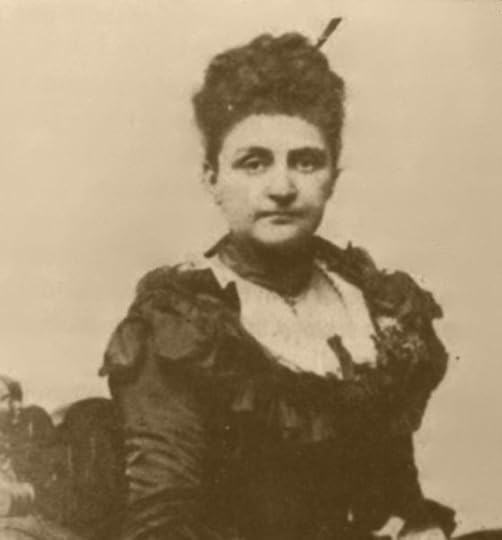
Next month: Caught on camera—the darker role that photography played in spiritualism
Find out more at michaelgallagherwrites.com

Why the Victorians Saw Ghosts – An Illustrated Guide to 19th Century Spiritualism is now available as an ebook. Visit the “My Shout” page on my website for details of a free download.
Images:
Florence Cook (1856-1904)
Photographer and date unknown
Katie King
Photograph by William Crookes (1832-1919), circa 1873/1874
Katie King
Photograph by William Crookes (1832-1919), circa 1873/1874
Mrs Edward Elgie Corner (1856-1904)
Photographer and date unknown
Published on January 01, 2014 06:32
•
Tags:
agnes-guppy, crookes, edward-william-cox, florence-cook, katie-king, marryat, materializing-medium, rosina-showers, spiritualism, spiritualists, victorian-mediums, victorian-seances, volckmann
Why the Victorians saw ghosts: Caught on camera—the darker role that photography played in spiritualism
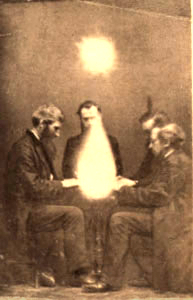 While I was researching my novel,
The Bridge of Dead Things
, I came to understand that the Victorian vogue for spiritualism did not happen in a vacuum. It grew out of a very specific culture, at a particular point in time, and it fulfilled a number of surprisingly different needs. This is the eighth in a series of posts that examines various influences on the development of spiritualism.
While I was researching my novel,
The Bridge of Dead Things
, I came to understand that the Victorian vogue for spiritualism did not happen in a vacuum. It grew out of a very specific culture, at a particular point in time, and it fulfilled a number of surprisingly different needs. This is the eighth in a series of posts that examines various influences on the development of spiritualism.It probably started out as a happy accident: a glass plate that had previously been exposed but not yet developed was placed back into the camera and exposed for a second time. The resulting double-exposure, when printed, would have produced a somewhat ghostly effect. With a certain amount of pre-planning and a little tweaking here and there, the effect could be heightened and repeated time and time again. Such is undoubtedly the case with the American William H. Mumler (1832-1884), who started out as an amateur photographer in Boston. Realising that he could make his living by photographing New England’s many mediums in the company of assorted spirits, he quit his job as an engraver and moved to New York in the early 1860s to take up his particular brand of photography full time. His most famous photo appears to show Mary Todd Lincoln flanked by the spirit of her dead husband.
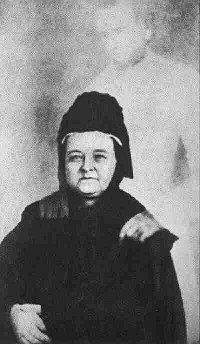
In the April of 1869 Mumler was brought to trial for fraud after it was alleged that he’d broken into houses to steal the portraits of his sitters’ dead relatives. One of the witnesses to testify against him was the showman and entrepreneur P. T. Barnum. Barnum had commissioned the photographer Abraham Borgadus to make a portrait of him accompanied by Abraham Lincoln’s spirit, just like Mary’s, to demonstrate how easily it was that such photos could be faked. The photograph was presented in evidence at the trial. Although Mumler was eventually acquitted, his career as a spirit photographer was over.
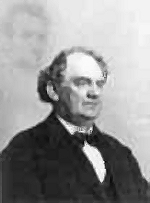
How could people be so gullible? To answer this question it's important to appreciate the naivety of the general public in their ability to read and understand photographs at the time. The following extract is from Statement of a Photographic Man, from Volume 3, Part IV (Street artists) of Henry Mayhew's 1861 work, London Labour and the London Poor. The speaker is a young working-class man from the slums of Lambeth, who, on tiring of busking for his living, borrows money for a camera and darkroom equipment and sets up as a photographer with his mate Jim, though both men lack the technical expertise required. Through trial and error his work gradually improves, but along the way he dreams up a number of hilarious tricks and dodges to mask his failures, one of which, the fobbing-off on impatient customers of hastily-wrapped specimen-photographs taken from his window display, he discusses here:
"…We have made some queer mistakes doing this. One day a young lady came in, and wouldn't wait, so Jim takes a specimen from the window, and, as luck would have it, it was the portrait of a widow in her cap. She insisted on opening, and then she said, 'This isn't me; it's got a widow's cap, and I was never married in all my life!' Jim answers, 'Oh, miss! why it's a beautiful picture, and a correct likeness,'—and so it was, and no lies, but it wasn't of her. Jim talked to her, and says he, 'Why this ain't a cap, it's the shadow of the hair'—for she had ringlets—and she positively took it away believing that such was the case; and even promised to send us customers, which she did.
"There was another lady that came in a hurry, and would stop if we were not more than a minute; so Jim ups with a specimen, without looking at it, and it was the picture of a woman and her child. We went through the business of focussing the camera, and then gave her the portrait and took the 6d [half a shilling]. When she saw it she cries out, 'Bless me! there's a child: I haven't ne'er a child!' Jim looked at her, and then at the picture, as if comparing, and says he, 'It is certainly a wonderful likeness, miss, and one of the best we ever took. It's the way you sat; and what has occasioned it was a child passing through the yard.' She said she supposed it must be so, and took the portrait away highly delighted.
"Once a sailor came in, and as he was in haste, I shoved on to him the picture of a carpenter, who was to call in the afternoon for his portrait. The jacket was dark, but there was a white waistcoat; still I persuaded him that it was his blue Guernsey which had come up very light, and he was so pleased that he gave us 9d [three-quarters of a shilling] instead of 6d. The fact is, people don't know their own faces. Half of 'em have never looked in a glass half a dozen times in their life, and directly they see a pair of eyes and a nose, they fancy they are their own.
"The only time we were done was with an old woman. We had only one specimen left, and that was a sailor man, very dark—one of our black pictures. But she put on her spectacles, and she looked at it up and down, and says, 'Eh?' I said, 'Did you speak, ma'am?' and she cries, 'Why, this is a man! here's the whiskers.' I left, and Jim tried to humbug her, for I was bursting with laughing. Jim said, 'It's you ma'am; and a very excellent likeness, I assure you.' But she kept on saying, 'Nonsense, I ain't a man,' and wouldn't have it. Jim wanted her to leave a deposit, and come next day, but she never called…"
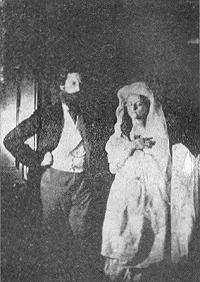
The photographs of the spirit of Katie King, however, stretch credulity to a brand new level. The first set was taken in a hotel room at Florence Cook's request by the reporter W. H. Harrison with an eye to publication in The Daily Telegraph; the rest—the ones we're most familiar with today—were taken by the scientist William Crookes at two private but well-attended soirées in his own home. In both cases neither the negatives nor the prints were tampered with in any way, and, considering the circumstances, it seems unlikely that Crookes (if not Harrison too) set out to perpetrate any fraud. But, studying them, it's hard to imagine that anyone was fooled. The words of Edward William Cox when describing one of Katie's later appearances sum up the situation neatly, "They were solid flesh and blood and bone."
People see what they want to see. The photo you see below is another interesting case in point. It was taken by a sixteen-year-old in 1917 and features her nine-year-old cousin sitting in their garden surrounded by a number of posed, cut-out fairy figures.
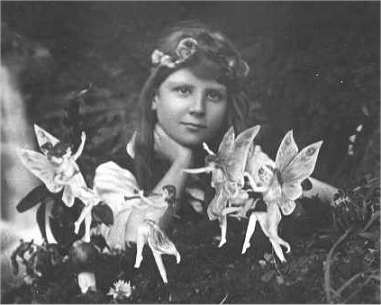
Again, there is no double-exposure or tampering with the print. What you see is exactly what you get. Yet this image was passionately championed by Sir Arthur Conan Doyle, author of the Sherlock Holmes series, who, despite his naivety, was a great believer in spiritualism. And he was not the only person to be taken in. Here is what Edward Gardner, a leading member of the Theosophical Society at the time, had to say: "…the fact that two young girls had not only been able to see fairies, which others had done, but had actually for the first time ever been able to materialise them at a density sufficient for their images to be recorded on a photographic plate, meant that it was possible that the next cycle of evolution was underway."
Frances, the young girl in the photo, finally admitted to the fraud in later life: "I never even thought of it as being a fraud—it was just Elsie and I having a bit of fun and I can't understand to this day why they were taken in—they wanted to be taken in."
Fifty years after Mumler, professional debunkers—often stage magicians who objected to their artistry being brought into disrepute by spiritualist hoaxers—were still at work trying to expose the tricks involved in the production of spirit photography. Here is one of the most recent examples I could find, showing Houdini, one of the greatest escapologists and debunkers of all time, with (yet again) the ghost of Abraham Lincoln, who must surely be the most photographed "spirit" on the planet.

Next time: Ghost-grabbers—tackling the spirits head-on
Find out more at michaelgallagherwrites.com
 Why the Victorians Saw Ghosts – An Illustrated Guide to 19th Century Spiritualism is now available as an ebook. It retails for US$2.99 in most online stores, but you can download it for free. You’ll find details and links on the My Shout page of my website.
Why the Victorians Saw Ghosts – An Illustrated Guide to 19th Century Spiritualism is now available as an ebook. It retails for US$2.99 in most online stores, but you can download it for free. You’ll find details and links on the My Shout page of my website.Images:
Seance conducted by John Beattie, in Bristol, England
Photograph by Eugene Rochas, 1872
Mary Todd Lincoln with the ghost of Abraham Lincoln
Photograph by William H. Mumler, date unknown but presumably prior to 1869
P. T. Barnum with the ghost of Abraham Lincoln, made at Barnum's request
Photograph by Abraham Bogardus, 1869
William Crookes with the spirit of Katie King
Photograph by William Crookes, circa 1873
Frances Griffiths surrounded by fairies
Photograph by Elsie Wright, 1917
Houdini with the ghost of Abraham Lincoln, made at Houdini's request
Photographer unknown, circa 1920-1930
Library of Congress
Published on February 01, 2014 06:14
•
Tags:
barnum, crookes, florence-cook, houdini, lincoln, mayhew, mediums, mumler, pictures-of-ghosts, seances, spirit-photography, spiritualism, spiritualists, statement-of-a-photographic-man, victorian-mediums, victorian-seances



